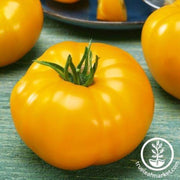Out Of Stock!
We will notify you when this product becomes available.
Tomato Seeds - Slicing - Sparks
80-90 Days to maturity (from transplant). Solanum lycopersicum. Sparks Tomato Seeds. Non-GMO, warm season annual, open-pollinated, heirloom, potato leaf, indeterminate, slicing. Suitable for growing in garden plots, raised beds, and greenhouses. Sparks Tomatoes are a potato leaf plant that produces large 3-inch perfect beefsteak tomatoes. ~ 6,800 seeds/ounce.




Download Free Vegetable Growing Guide PDF
Growing Sparks Tomatoes in the Vegetable Garden
When growing Sparks tomatoes, it is recommended to plant the seeds indoors 7-9 weeks before setting them outside. The seeds should be sown in a warm area and receive plenty of sunlight. The optimum temperatures for growing tomatoes are between 80 and 85 degrees Fahrenheit. Using coco coir or another germination mix is advisable for the best germination results. Additionally, the plants should be grown in fertile, slightly acidic soil in a well-drained location in the garden. Working the soil thoroughly before planting and adding well-rotted manure and compost can help provide the necessary nutrients for the plants.
Once the seedlings are 2 inches tall and have at least two sets of true leaves, harden them off. To harden off tomato plants, gradually expose them to outdoor conditions over a week to ten days. Start by placing them in a shaded spot outdoors for one hour on the first day, then increase the time each day. Choose clear or overcast days with temperatures over 60°F and minimal wind. This process thickens the cuticle and waxy layers on the leaves, protecting the plants from UV rays and promoting stronger growth. Hardening off should be done to help the plants adapt to the outdoor environment, preventing shock and increasing their resilience to variable weather conditions. It is important to follow this gradual process to ensure the plants are well-prepared for the transition from indoor to outdoor environments, ultimately leading to healthier and more robust tomato plants.
Proper spacing and planting are also essential to ensure adequate air circulation and minimize the risk of diseases. Due to the nature of indeterminate tomato varieties, it is important to support the plants. Using 5 to 6-foot cages can help prevent branches from breaking due to the weight of the tomatoes. Regularly checking the plants and pinching off suckers and side branches where leaves join the stems can help manage the plant size and improve air circulation, which is beneficial for overall plant health and fruit development.
Keeping the soil consistently moist but not waterlogged is important for Sparks tomatoes. It is recommended to water well during dry and hot spells, preferably in the morning and on the side of the plants, avoiding direct water on the leaves. Watering early in the day can help prevent fungal or bacterial diseases. It is recommended to water deeply at least once a week if there is no rainfall. Mulching the soil surface with organic materials like shredded leaves or straw can help maintain soil moisture, reduce weed growth, and minimize the splashing of soil-borne pathogens onto the foliage, contributing to overall plant healthFertilizing the plants with slow-release fertilizer when transplanting outdoors and applying a diluted liquid feed every two weeks can help ensure they receive sufficient nutrients for growth and fruit development
Harvesting Sparks Tomatoes
Frequent harvesting is beneficial as it encourages the plant to produce more fruit. The plant is stimulated to continue its fruiting process by picking ripe fruit promptly, leading to a prolonged and abundant harvest. Harvesting tomatoes at the color break stage when they are slightly green can also be advantageous. This practice can help shield the plant against harmful pests and minimize the risk of damage caused by adverse weather conditions. Additionally, harvesting tomatoes at this stage can encourage the plant to produce new blossoms throughout the season, further contributing to a strong and continuous harvest.
About Sparks Tomato Garden Seeds
Sparks tomatoes, also known as Gold Spark tomatoes, are large, dark yellow tomatoes with delicious, sweet, and meaty flesh. They are an indeterminate variety, meaning they continue to grow and produce fruit throughout the season.<
Sparks Tomatoes are a potato leaf variety that produces large 3-inch perfect, yellow-orange, juicy, round beefsteak tomatoes with a delicious taste.
They are highly adaptable and yield heavy clusters of these flavorful tomatoes. The variety is known for its high resistance to diseases such as Alternaria Stem Canker, Early Blight, Fusarium Wilt, Fusarium Crown and Root Rot, Gray Leaf Spot, Late Blight, Leaf Mold, and Roundworm Nematode.
The fruits are rich in nutrients and antioxidants, including the especially potent lycopene, which is found in its highest concentration in tomatoes. Lycopene supports healthy eyesight, cardiovascular health, and has cancer-fighting properties.
The plants' indeterminate nature allows for a prolonged harvest season, providing a bountiful supply of these flavorful tomatoes. Whether grown in home gardens or on a larger scale, Sparks tomatoes are valued for their rich flavor and versatility in various culinary applications.
Stores From Our Gardeners
"Each tomato variety has its own story, a journey that connects me to the farmers, seed savers, and enthusiasts who preserved and shared them. Trying different tomato varieties connects us to other people and cultures."
 |
- Lara Wadsworth, True Leaf Market Writer |
Other Resources
Sparks Tomato Seeds Per Package:
- 300 mg packet - Approximately 65 Seeds
- .25 oz - Approximately 1,700 Seeds
- 1 oz - Approximately 6,800 Seeds
- 4 oz - Approximately 27,200 Seeds
- 1 lb - Approximately 108,800 Seeds
Non-GMO Sparks Tomato seeds are available for Fast Free Shipping on qualifying orders.
Basic Info
| Latin Name: | Solanum lycoperscium (previously Lycopersicon esculentum) |
| Tomato Type: | Slicing - Larger, round tomatoes, the size of your fist or larger. |
| Sparks Tomato Color: | Yellow |
| Sparks Tomato Flavor: | Sweet, mild, juicy |
Growing Info
| Hardiness Zone: | 2, 3, 4, 5, 6, 7, 8, 9, 10, 11 Annual: Not intended to overwinter |
| Days to Maturity: | 80-90 (from transplant) |
| Days to Germination: | 7-10 |
| Seeding Depth: | 0.25 inch |
| Plant Spacing: | 24-36 inches |
| Row Spacing: | 36 inches |
| Plant Height: | 36-96 inches |
| Growth Habit: | Indeterminate - Indeterminate tomatoes are vine-type plants that sprawl (requiring a cage or trellis to support them) and continue to grow throughout the season. Indeterminate tomato plants will continue to produce tomatoes for the rest of the season, so you can harvest continually. |
| Soil Preference: | Well-draining, loose (sandy loam), slightly acidic (6.2 to 6.8), and moisture retaining. Too much nitrogen in the soil may lead to more foliage production and less fruiting. Tomatoes like more phosphorus and potassium than other vegetables. |
| Temperature Preference: | Warmer (70-85 F) |
| Light Preference: | Full Sun |
Other
| Direct Sow: | No |
| Start Indoors: | Yes. Start Indoors 7-9 weeks before your last spring frost date. |
| Plant Width: | 24 inches |
| Plant Spread: | 24 inches |
| Growth Speed: | Late - Ready to harvest from 81 days or more from transplant. Difficult, if not impossible, to get a tomato by the 4th of July with these varieties. They are good late-summer to early-fall producers for most USDA Zones. |
| Germination Temperature: | 65-85 F |
| Pests and Diseases: | Common pests known to harm tomato plants, in general, include the tomato hornworm, cutworm, aphids, flea beetles, tomato fruit worms, and whiteflies. Also, watch for common diseases such as blossom end rot, fusarium wilt, powdery mildew, verticillium wilt, late blight, bacterial canker/spot, and tobacco mosaic virus. Most of these can be prevented by maintaining a regular watering schedule and avoiding overwatering. Regularly check your plants for pest damage throughout the season. For treating pest and disease problems, we recommend using an organic neem-based product. |
| Garden Size: | Greenhouse, Garden Plot, Raised Bed |
| Tomato Use: | Salads, fresh eating, slicing |














